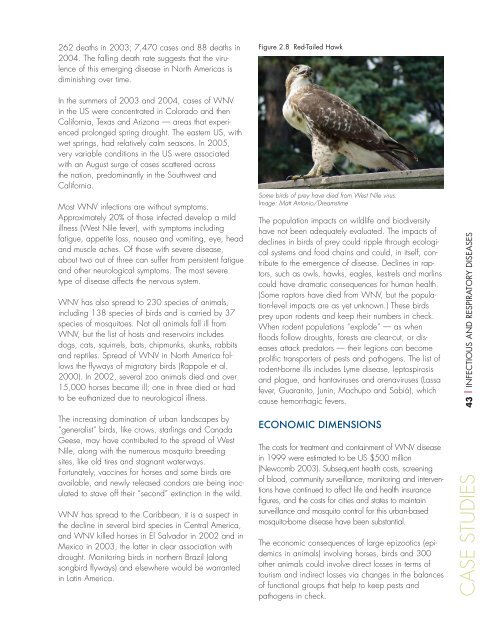Climate change futures: health, ecological and economic dimensions
Climate change futures: health, ecological and economic dimensions
Climate change futures: health, ecological and economic dimensions
Create successful ePaper yourself
Turn your PDF publications into a flip-book with our unique Google optimized e-Paper software.
262 deaths in 2003; 7,470 cases <strong>and</strong> 88 deaths in<br />
2004. The falling death rate suggests that the virulence<br />
of this emerging disease in North Americas is<br />
diminishing over time.<br />
Figure 2.8 Red-Tailed Hawk<br />
In the summers of 2003 <strong>and</strong> 2004, cases of WNV<br />
in the US were concentrated in Colorado <strong>and</strong> then<br />
California, Texas <strong>and</strong> Arizona — areas that experienced<br />
prolonged spring drought. The eastern US, with<br />
wet springs, had relatively calm seasons. In 2005,<br />
very variable conditions in the US were associated<br />
with an August surge of cases scattered across<br />
the nation, predominantly in the Southwest <strong>and</strong><br />
California.<br />
Most WNV infections are without symptoms.<br />
Approximately 20% of those infected develop a mild<br />
illness (West Nile fever), with symptoms including<br />
fatigue, appetite loss, nausea <strong>and</strong> vomiting, eye, head<br />
<strong>and</strong> muscle aches. Of those with severe disease,<br />
about two out of three can suffer from persistent fatigue<br />
<strong>and</strong> other neurological symptoms. The most severe<br />
type of disease affects the nervous system.<br />
WNV has also spread to 230 species of animals,<br />
including 138 species of birds <strong>and</strong> is carried by 37<br />
species of mosquitoes. Not all animals fall ill from<br />
WNV, but the list of hosts <strong>and</strong> reservoirs includes<br />
dogs, cats, squirrels, bats, chipmunks, skunks, rabbits<br />
<strong>and</strong> reptiles. Spread of WNV in North America follows<br />
the flyways of migratory birds (Rappole et al.<br />
2000). In 2002, several zoo animals died <strong>and</strong> over<br />
15,000 horses became ill; one in three died or had<br />
to be euthanized due to neurological illness.<br />
Some birds of prey have died from West Nile virus.<br />
Image: Matt Antonio/Dreamstime<br />
The population impacts on wildlife <strong>and</strong> biodiversity<br />
have not been adequately evaluated. The impacts of<br />
declines in birds of prey could ripple through <strong>ecological</strong><br />
systems <strong>and</strong> food chains <strong>and</strong> could, in itself, contribute<br />
to the emergence of disease. Declines in raptors,<br />
such as owls, hawks, eagles, kestrels <strong>and</strong> marlins<br />
could have dramatic consequences for human <strong>health</strong>.<br />
(Some raptors have died from WNV, but the population-level<br />
impacts are as yet unknown.) These birds<br />
prey upon rodents <strong>and</strong> keep their numbers in check.<br />
When rodent populations “explode” — as when<br />
floods follow droughts, forests are clear-cut, or diseases<br />
attack predators — their legions can become<br />
prolific transporters of pests <strong>and</strong> pathogens. The list of<br />
rodent-borne ills includes Lyme disease, leptospirosis<br />
<strong>and</strong> plague, <strong>and</strong> hantaviruses <strong>and</strong> arenaviruses (Lassa<br />
fever, Guaranito, Junin, Machupo <strong>and</strong> Sabiá), which<br />
cause hemorrhagic fevers.<br />
43 | INFECTIOUS AND RESPIRATORY DISEASES<br />
The increasing domination of urban l<strong>and</strong>scapes by<br />
“generalist” birds, like crows, starlings <strong>and</strong> Canada<br />
Geese, may have contributed to the spread of West<br />
Nile, along with the numerous mosquito breeding<br />
sites, like old tires <strong>and</strong> stagnant waterways.<br />
Fortunately, vaccines for horses <strong>and</strong> some birds are<br />
available, <strong>and</strong> newly released condors are being inoculated<br />
to stave off their “second” extinction in the wild.<br />
WNV has spread to the Caribbean, it is a suspect in<br />
the decline in several bird species in Central America,<br />
<strong>and</strong> WNV killed horses in El Salvador in 2002 <strong>and</strong> in<br />
Mexico in 2003, the latter in clear association with<br />
drought. Monitoring birds in northern Brazil (along<br />
songbird flyways) <strong>and</strong> elsewhere would be warranted<br />
in Latin America.<br />
ECONOMIC DIMENSIONS<br />
The costs for treatment <strong>and</strong> containment of WNV disease<br />
in 1999 were estimated to be US $500 million<br />
(Newcomb 2003). Subsequent <strong>health</strong> costs, screening<br />
of blood, community surveillance, monitoring <strong>and</strong> interventions<br />
have continued to affect life <strong>and</strong> <strong>health</strong> insurance<br />
figures, <strong>and</strong> the costs for cities <strong>and</strong> states to maintain<br />
surveillance <strong>and</strong> mosquito control for this urban-based<br />
mosquito-borne disease have been substantial.<br />
The <strong>economic</strong> consequences of large epizootics (epidemics<br />
in animals) involving horses, birds <strong>and</strong> 300<br />
other animals could involve direct losses in terms of<br />
tourism <strong>and</strong> indirect losses via <strong>change</strong>s in the balances<br />
of functional groups that help to keep pests <strong>and</strong><br />
pathogens in check.<br />
CASE STUDIES

















